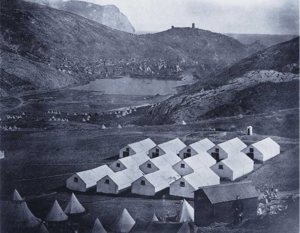James Robertson (photographer)
James Robertson (1813 — 1888) was an English photographer and gem and coin engraver who worked in the Mediterranean region, the Crimea and possibly India. He was one of the first war photographers.
Robertson was born in Middlesex in 1813. He trained as an engraver under Wyon (probably William Wyon) and in 1843 he began work as an "engraver and die-stamper" at the Imperial Ottoman Mint in Constantinople. It is believed that Robertson became interested in photography while in the Ottoman Empire in the 1840s.
In 1853 he began photographing with British photographer Felice Beato and the two formed a partnership called Robertson & Beato either in that year or in 1854 when Robertson opened a photographic studio in Pera, Constantinople. Robertson and Beato were joined by Beato's brother, Antonio on photographic expeditions to Malta in 1854 or 1856 and to Greece and Jerusalem in 1857. A number of the firm's photographs produced in the 1850s are signed Robertson, Beato and Co. and it is believed that "and Co." refers to Antonio.
In late 1854 or early 1855 Robertson married the Beato brothers' sister, Leonilda Maria Matilda Beato. They had three daughters, Catherine Grace (born in 1856), Edith Marcon Vergence (born in 1859) and Helen Beatruc (born in 1861).

In 1855 Robertson and Felice Beato travelled to Balaklava, Crimea where they took over reportage of the Crimean War from Roger Fenton. They photographed the fall of Sevastopol in September 1855.
Some sources have suggested that in 1857 both Robertson and Felice Beato went to India to photograph the aftermath of the Indian Rebellion, but it is more probable that Beato travelled there alone. Around this time Robertson did photograph in Palestine, Syria, Malta, and Cairo with either or both of the Beato brothers.
In 1860, after Felice Beato left for China to photograph the Second Opium War and Antonio Beato went to Egypt, Robertson briefly teamed up with Charles Shepherd back in Constantinople. The firm of Robertson & Beato was dissolved in 1867, having produced images - including remarkable multiple-print panoramas - of Malta, Greece, Turkey, Damascus, Jerusalem, Egypt, the Crimea and India. Robertson possibly gave up photography in the 1860s; he returned to work as an engraver at the Imperial Ottoman Mint until his retirement in 1881. In that year he left for Yokohama, Japan, arriving in January 1882. He died there in April 1888.
References
- Auer, Michèle, and Michel Auer. Encyclopédie internationale des photographes de 1839 à nos jours/Photographers Encyclopaedia International 1839 to the Present (Hermance: Editions Camera Obscura, 1985).
- Benaki Museum. James Robertson (1813-1888). Accessed 26 May 2008.
- Clark, John. Japanese Exchanges in Art, 1850s to 1930s with Britain, continental Europe, and the USA: Papers and Research Materials (Sydney: Power Publications, 2001), pp. 89–91, 113.
- Harris, David. Of Battle and Beauty: Felice Beato's Photographs of China (Santa Barbara: Santa Barbara Museum of Art, 1999).
- James Robertson: Photographer of Istanbul (London: The British Council, n.d.).
- Oztuncay, Bahattin. James Robertson: Pioneer of Photography in the Ottoman Empire (Istanbul: Eran, 1992).
- Union List of Artist Names, s.v. "Robertson, James". Accessed 3 April 2006.
External links
| Wikimedia Commons has media related to James Robertson. |
- Donnelly, Peter, curator. The King's Own Royal Regiment Museum (Lancaster); Photo Gallery, Crimean War 1854-1856. Accessed 7 November 2007.
- The Hurriyet Daily News.
- Commemorating a photographer in Istanbul